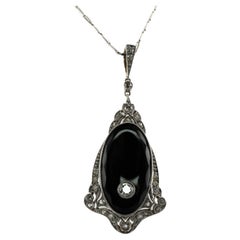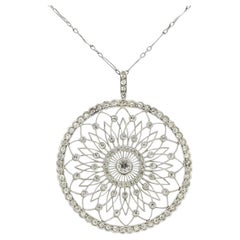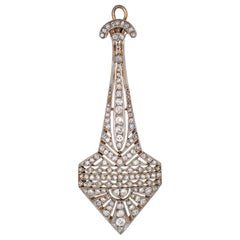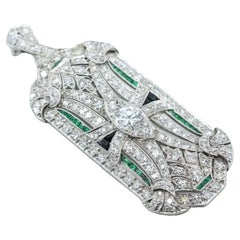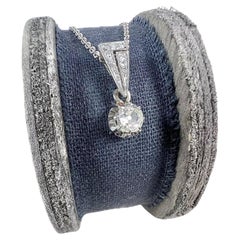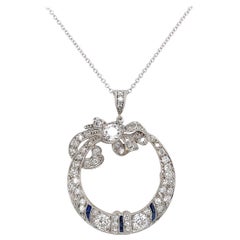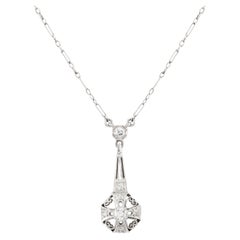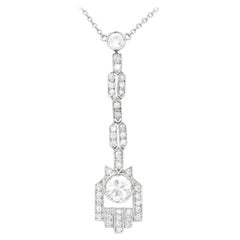Art Deco Diamond Pendants
Mid-20th Century Pendant Necklaces
Diamond, Onyx, 14k Gold, White Gold, Yellow Gold
Vintage 1930s Art Deco Pendant Necklaces
Diamond, Pink Diamond, Platinum
Early 20th Century Art Deco Pendant Necklaces
Diamond, Pink Diamond, Platinum
Early 20th Century Unknown Art Deco Pendant Necklaces
Diamond, White Diamond
Mid-20th Century Art Deco Pendant Necklaces
Diamond, Emerald, Onyx, Platinum
Early 20th Century French Art Deco Pendant Necklaces
Diamond, 18k Gold, White Gold, Platinum
Mid-20th Century Art Deco Pendant Necklaces
Diamond
Early 20th Century Art Deco Pendant Necklaces
Diamond, Platinum
Vintage 1920s Unknown Art Deco Pendant Necklaces
Diamond, Platinum
20th Century Indian Retro Pendant Necklaces
White Diamond, Brown Diamond, 18k Gold, White Gold
Vintage 1920s French Art Deco Pendant Necklaces
Diamond, White Diamond, Gold, 18k Gold, White Gold
Vintage 1920s Unknown Art Deco Pendant Necklaces
Diamond, 18k Gold, Yellow Gold
Vintage 1940s French Art Deco Pendant Necklaces
Diamond, Platinum
Vintage 1920s Art Deco Pendant Necklaces
Amethyst, Diamond, 18k Gold
Vintage 1930s American Art Deco Pendant Necklaces
Diamond, Jade, 18k Gold, Platinum
Early 20th Century Art Deco Pendant Necklaces
Diamond
20th Century Art Deco Pendant Necklaces
Diamond, Platinum
Early 20th Century Art Deco Pendant Necklaces
Diamond, Sapphire, Blue Sapphire, Platinum
Mid-20th Century Art Deco Pendant Necklaces
Diamond, Pearl, 18k Gold
Vintage 1930s Art Deco Pendant Necklaces
Diamond, Platinum
Vintage 1930s Art Deco Pendant Necklaces
Diamond, Platinum
Vintage 1920s European Art Deco Pendant Necklaces
Diamond, Sapphire
Vintage 1930s Art Deco Pendant Necklaces
Diamond, Pearl, Platinum
Vintage 1920s Art Deco Pendant Necklaces
Aquamarine, Diamond, Platinum
Vintage 1930s Art Deco Pendant Necklaces
Diamond, Sapphire, 14k Gold, White Gold
Vintage 1930s Art Deco Pendant Necklaces
Diamond, Platinum
Vintage 1920s Italian Art Deco Pendant Necklaces
Diamond, 18k Gold, White Gold
Vintage 1920s Unknown Art Deco Pendant Necklaces
Diamond, Platinum
Vintage 1940s Art Deco Pendant Necklaces
Diamond, 18k Gold, White Gold
Mid-20th Century Art Deco Pendant Necklaces
Diamond, 18k Gold
Vintage 1930s Art Deco Pendant Necklaces
Diamond, Sapphire, 18k Gold, Yellow Gold, Platinum
Vintage 1940s Art Deco Pendant Necklaces
Diamond, Platinum
Antique 19th Century Art Deco Pendant Necklaces
Aquamarine, Diamond, Platinum
2010s American Art Deco Pendant Necklaces
Diamond, White Diamond, 18k Gold, White Gold
Vintage 1930s Unknown Art Deco Pendant Necklaces
Diamond, Onyx, Platinum
Early 20th Century Art Deco Pendant Necklaces
Diamond, Sapphire, Gold, 14k Gold, White Gold, Platinum
Vintage 1930s Art Deco Pendant Necklaces
Diamond, Sapphire, Platinum
2010s Thai Art Deco Pendant Necklaces
Diamond, Emerald, White Gold
20th Century British Art Deco Pendant Necklaces
Diamond, Sapphire, Platinum
Early 20th Century Art Deco Pendant Necklaces
Diamond, Platinum
21st Century and Contemporary American Art Deco Pendant Necklaces
Diamond, 14k Gold
Vintage 1940s Unknown Art Deco Pendant Necklaces
Diamond, Gold, 14k Gold, White Gold
Vintage 1910s British Art Deco Pendant Necklaces
Diamond, Platinum
Early 20th Century Chinese Art Deco Pendant Necklaces
Diamond, 14k Gold
Early 20th Century Unknown Art Deco Pendant Necklaces
Diamond, Emerald, Platinum
Vintage 1920s Art Deco Pendant Necklaces
Diamond, Emerald, 14k Gold, White Gold, Platinum
Vintage 1940s Art Deco Pendant Necklaces
Diamond, Gold, 18k Gold, White Gold
20th Century Unknown Art Deco Pendant Necklaces
Aquamarine, Diamond, Platinum
Vintage 1930s Unknown Art Deco Pendant Necklaces
Diamond, Pearl, Platinum
Vintage 1930s Unknown Art Deco Drop Necklaces
Diamond, Platinum
Early 20th Century Art Deco Pendant Necklaces
Diamond, Platinum
Vintage 1920s Unknown Art Deco Pendant Necklaces
Diamond, Platinum
Vintage 1950s French Art Deco Pendant Necklaces
Diamond, 18k Gold
Vintage 1920s Pendant Necklaces
Diamond, 18k Gold, Platinum
Early 20th Century French Art Deco Pendant Necklaces
Diamond, 18k Gold, Yellow Gold
Mid-20th Century Art Deco Pendant Necklaces
Diamond, Platinum
Vintage 1930s European Art Deco Pendant Necklaces
Diamond, Turquoise, 18k Gold
Vintage 1920s Unknown Art Deco Pendant Necklaces
Diamond, Platinum
Early 20th Century Unknown Art Deco Pendant Necklaces
Diamond, Platinum
21st Century and Contemporary British Art Deco Pendant Necklaces
Diamond, Ruby, 18k Gold, White Gold
- 1
- ...
Art Deco Diamond Pendants For Sale on 1stDibs
How Much are Art Deco Diamond Pendants?
A Close Look at Art Deco Jewelry
Fascination with the Jazz Age is endless, and even today jewelry designers continue to be inspired by authentic Art Deco jewelry and watches.
The Art Deco period, encompassing the 1920s and ’30s, ushered in a very distinct look in the design of jewelry. There were many influences on the jewelry of the era that actually began to take shape prior to the 1920s. In 1909, Serge Diaghilev brought the Ballet Russes to Paris, and women went wild for the company’s exotic and vibrant costumes It’s no wonder, then, that jade, lapis lazuli, coral, turquoise and other bright gemstones became all the rage. There already existed a fascination with the East, particularly China and Japan, and motifs consisting of fans and masks started to show up in Art Deco jewelry.
However, the event that had the greatest influence on Deco was the excavation of the tomb of King Tut in 1922. When the world saw what was hidden in Tut’s burial chamber, it sent just about everyone into a frenzy. Pierre Cartier wrote in 1923 that “the discovery of the tomb will bring some sweeping changes in fashion jewelry.” And he couldn’t have been more right. “Egyptomania” left an indelible mark on all of the major jewelry houses, from Cartier to Van Cleef & Arpels, Boucheron and Georges Fouquet. (Cartier created some of the most iconic jewelry designs that defined this era.)
While a lot of Art Deco jewelry was black and white — the black coming from the use of onyx or black enamel and the white from rock crystal and diamonds — there is plenty of color in jewelry of the era. A perfect accent to diamonds in platinum settings were blue sapphires, emeralds and rubies, and these stones were also used in combination with each other.
Many designers employed coral, jade and lapis lazuli, too. In fact, some of the most important avant-garde jewelers of the period, like Jean Després and Jean Fouquet (son of Georges), would combine white gold with ebony and malachite for a jolt of color.
A lot of the jewelry produced during this time nodded to current fashion trends, and women often accessorized their accessories. The cloche hat was often accented with geometric diamond brooches or double-clip brooches. Backless evening dresses looked fabulous with sautoir necklaces, and long pearl necklaces that ended with tassels, popular during the Edwardian period, were favored by women everywhere, including Coco Chanel.
Find unique Art Deco necklaces, earrings, bracelets and other jewelry on 1stDibs.
The Legacy of Diamond in Jewelry Design
Antique diamond rings, diamond tiaras and dazzling vintage diamond earrings are on the wish lists of every lover of fine jewelry. And diamonds and diamond jewelry are primarily associated with storybook engagements and red-carpet grand entrances — indeed, this ultra-cherished gemstone has a dramatic history on its hands.
From “A Diamond Is Forever” to “Diamonds Are a Girl’s Best Friend,” pop culture has ingrained in our minds that diamonds are the most desired, the most lasting and the most valuable gemstone. But what makes the diamond so special? Each stone — whether it’s rubies, sapphires or another stone — is unique and important in its own right. April babies might claim diamonds for themselves, but just about everyone wants this kind of sparkle in their lives!
There are several factors that set diamonds apart from other stones, and these points are important to our gem education.
Diamonds are minerals. They are made up of almost entirely of carbon (carbon comprises 99.95 percent; the remainder consists of various trace elements). Diamonds are the hardest gemstones, ranking number 10 on the Mohs Hardness Scale. Even its name, diamond, is rooted in the Greek adamas, or unconquerable. The only object that can scratch a diamond is another diamond. Diamonds are formed deep within the earth at very high temperatures (1,652–2,372 degrees Fahrenheit at depths between 90 and 120 miles beneath the earth’s surface) and are carried up by volcanic activity. Diamonds are quite rare, according to the Gemological Institute of America, and only 30 percent of all the diamonds mined in the world are gem quality.
In the 1950s, the Gemological Institute of America developed the 4Cs grading system to classify diamonds: clarity, color, cut and carat weight. Not all diamonds are created equal (there are diamonds, and then there are diamonds). The value of the diamond depends on the clarity (flawless diamonds are very rare but a diamond's value decreases if there are many blemishes or inclusions), color (the less color the higher the grade), cut (how the diamond’s facets catch the light, certain cuts of diamonds show off the stone better than others) and carat weight (the bigger, the better).
When you start shopping for a diamond engagement ring, always prioritize the cut, which plays the largest role in the diamond's beauty (taking the time to clean your diamond ring at least every six months or so plays a role in maintaining said beauty). And on 1stDibs, a range of buying guides can be found for those in the market for antique engagement rings, vintage engagement rings or Art Deco engagement rings.
Shop antique and vintage diamond rings, diamond necklaces and other extraordinary diamond jewelry on 1stDibs.
Finding the Right Pendant Necklaces for You
Whether you’re layering multiple jewelry pieces or opting for a single strand, vintage pendant necklaces are versatile accessories that can elevate your casual wear as easily as they can add a creative flourish to your formal attire.
The earliest jewelry was less about accessorizing than it was about wearers arming themselves with amulets. In Ancient Egypt, some amulets featured a loop so that they could be strung around one’s neck. While rubies have long been one of the few gemstones that can give diamonds a run for their money, members of some ancient civilizations valued the stones from the get-go, donning ruby pendants as well as other stones with the belief that these adornments would bring protection, healing powers or strength. Today, we still wear our charm bracelets and charm pendants around our necks for good luck.
Later, pendant necklaces, like most fine jewelry, were worn strictly by royalty or the upper class and conferred wealth and prestige. This changed over time, thankfully, as wearing jewelry became more widespread, a democratized means of personal expression.
During the 18th and 19th centuries, pendant necklaces evolved from their status as spiritual amulets, but the jewels still carried deep personal significance. Victorian pendants, in particular, were part of the “mourning jewelry” tradition. Wearers would embed their pendants with locks of hair from a deceased loved one as a way of grieving in the wake of a loss. In the case of cameo jewelry, some pendants were even decorated with miniature hand-carved portraits in a detailed raised relief. Today, portraiture is still a characteristic of many of the hand-carved pendant necklaces offered by Italian jewelry house Scala Gioielli.
Luxury fine jewelry brands such as Cartier, BVLGARI and David Yurman offer their own unique interpretations of the cherished accessory, embellishing platinum or gold pendant necklaces with diamonds, sapphires and other stones.
On 1stDibs, find an extraordinary range of vintage pendant necklaces and other necklaces today.
